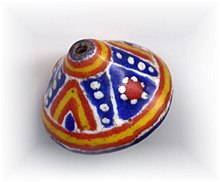

Kiffa beads are rare powder glass beads. They are named after the Mauritanian city of Kiffa, where French ethnologist R. Mauny documented them first in 1949.[1]
Kiffa beads represent one of the highest levels of artistic skill and ingenuity in beadmaking, being manufactured with the simplest materials and tools available: pulverized European glass beads or fragments of them, bottle glass, pottery shards, tin cans, twigs, steel needles, some gum arabic, and open fires. The term Kiffa bead, named after one of the old bead making centres of Kiffa in Mauritania, was coined by United States bead collectors during the 1980s.
According to Peter Francis, Jr., the making of powder glass beads in West Africa may date back a few hundred years, and to possibly 1200 CE in Mauritania. Maure powder glass beads are believed to copy older, Islamic beads, of the type made in Fustat and elsewhere. Although the making of Mauritanian powder glass beads appears to be an ancient tradition, no archaeological evidence to establish their age has been found to date.
- ^ Mauny, R (1949). "Fabrication de perles de verre en Mauritanie". Notes Africaines. 44: 116–118.